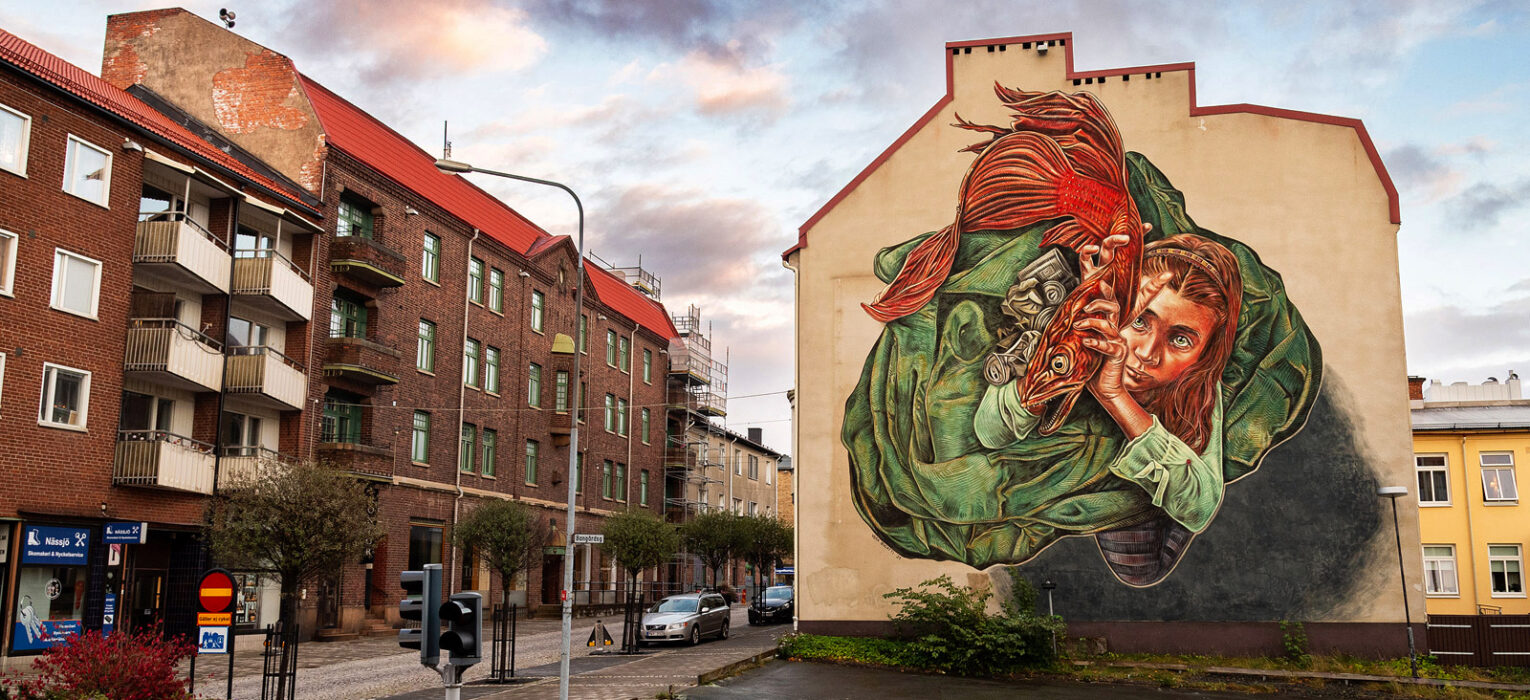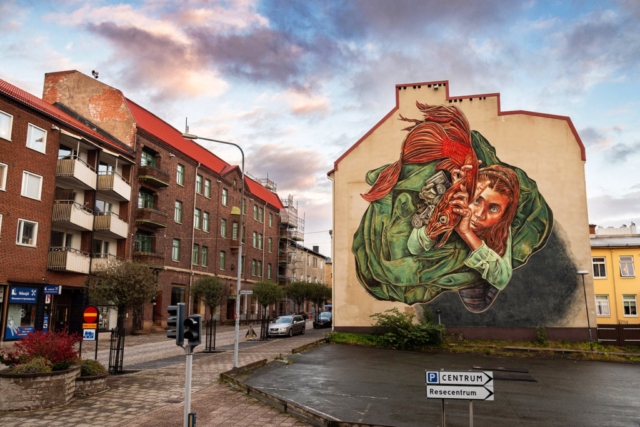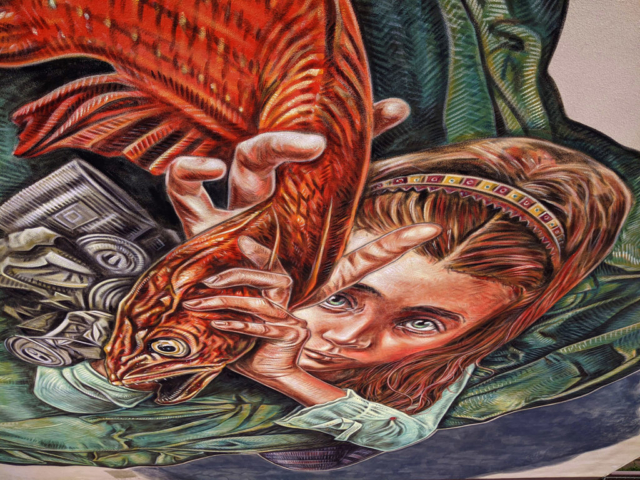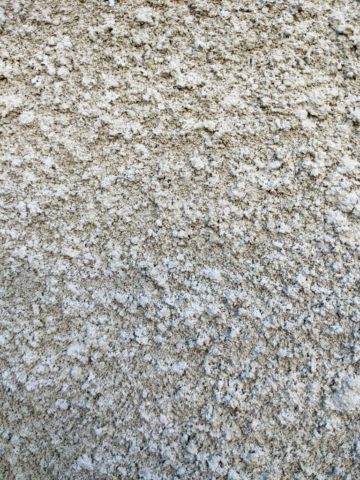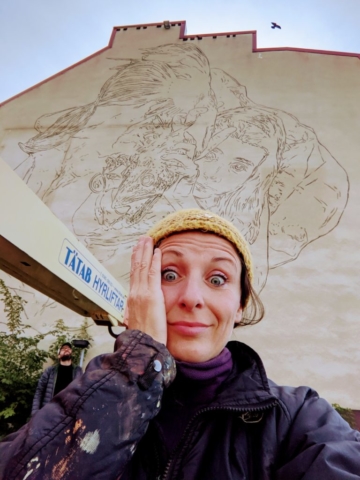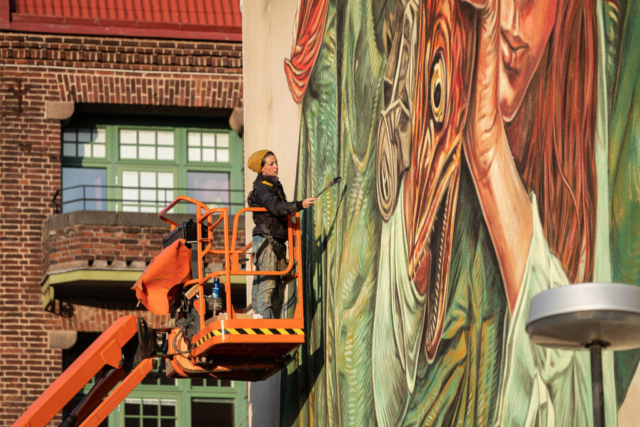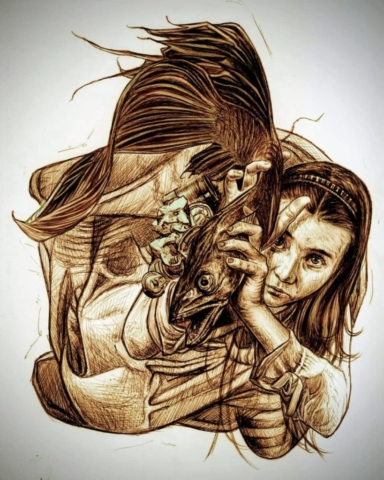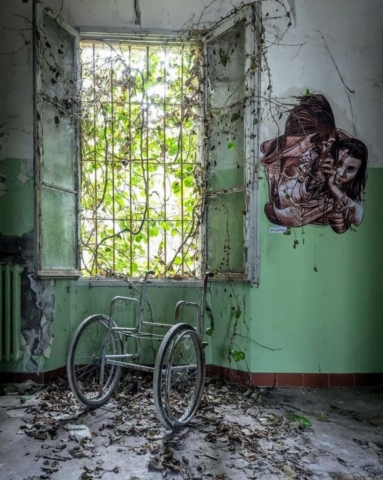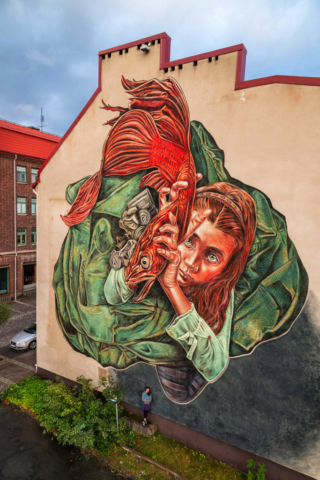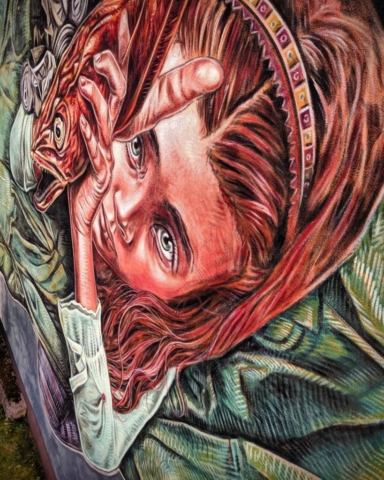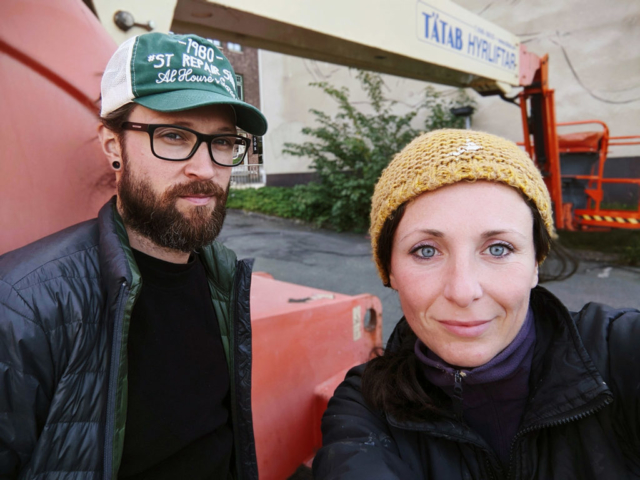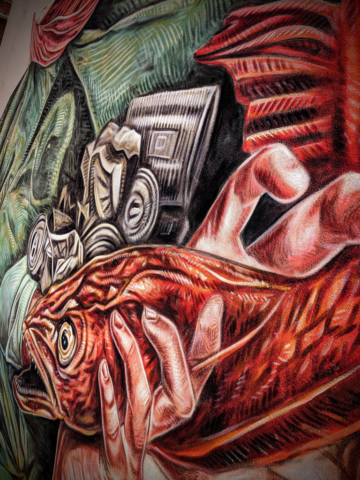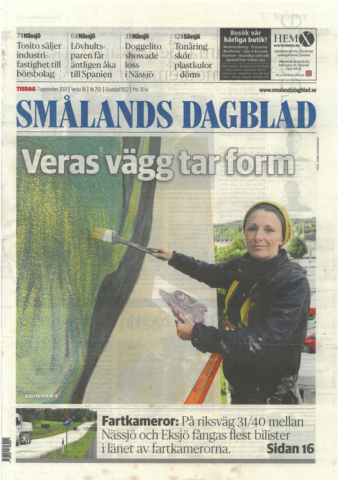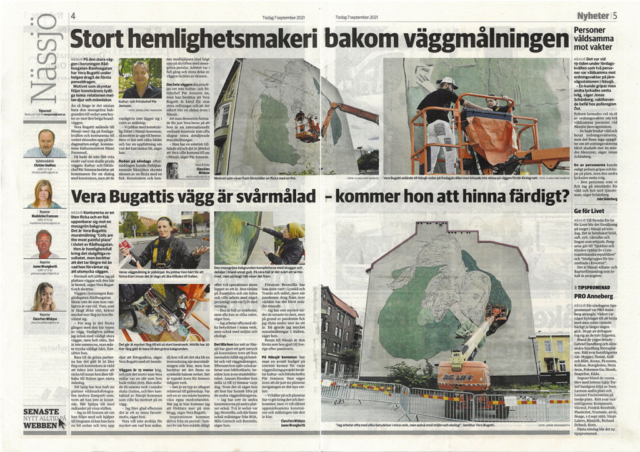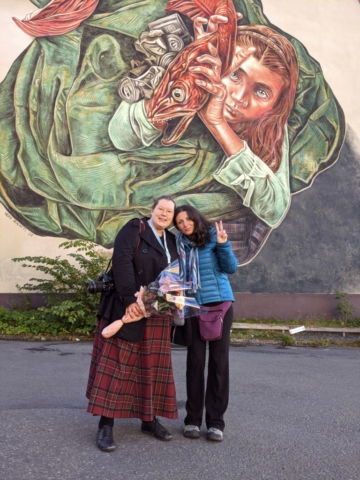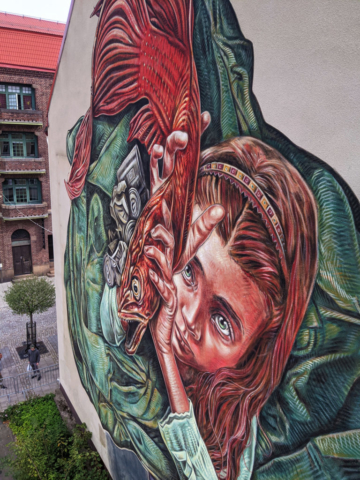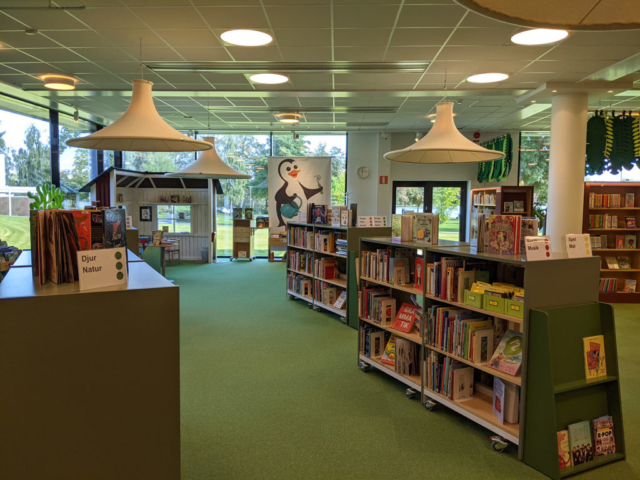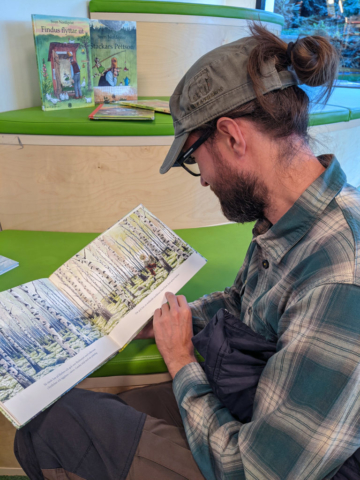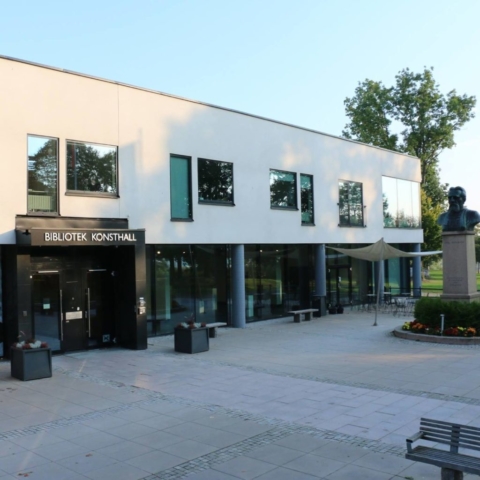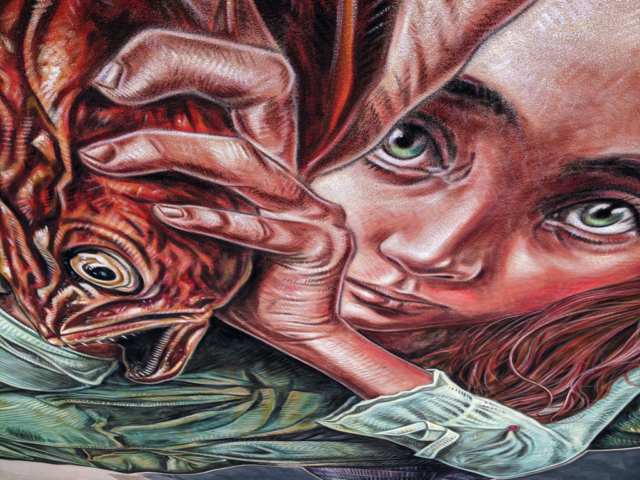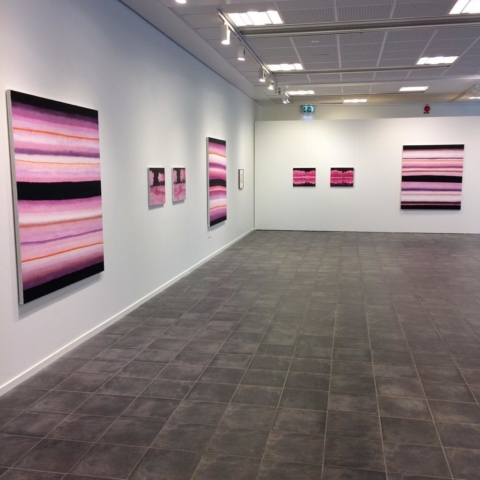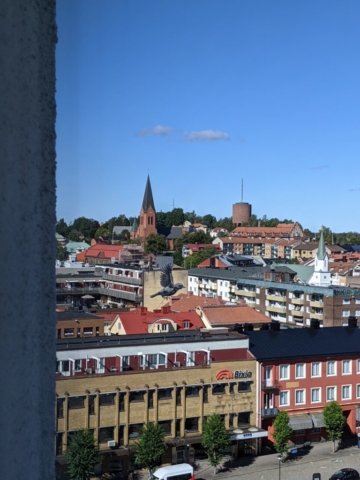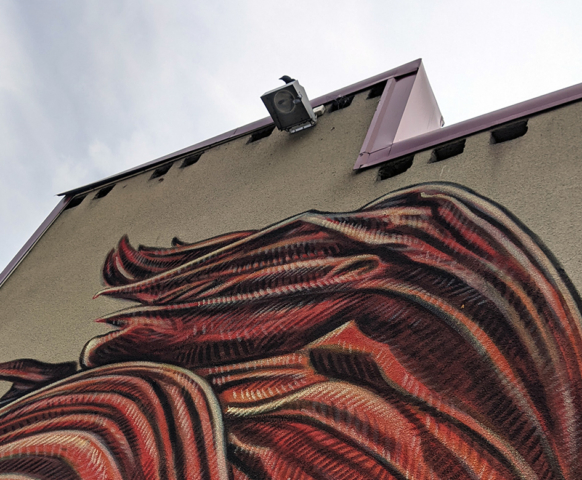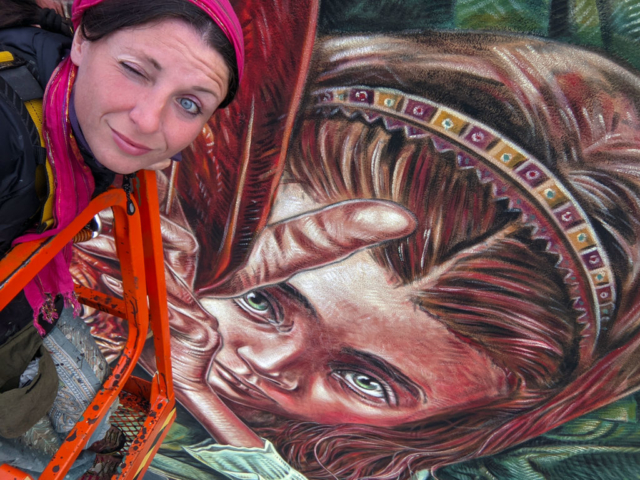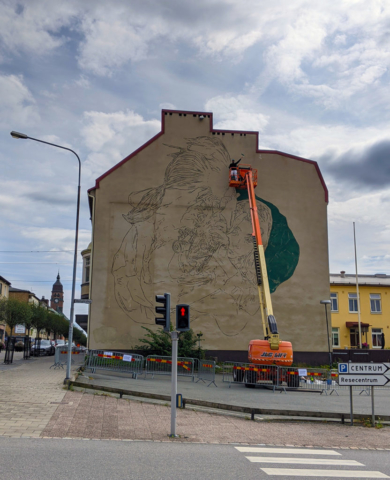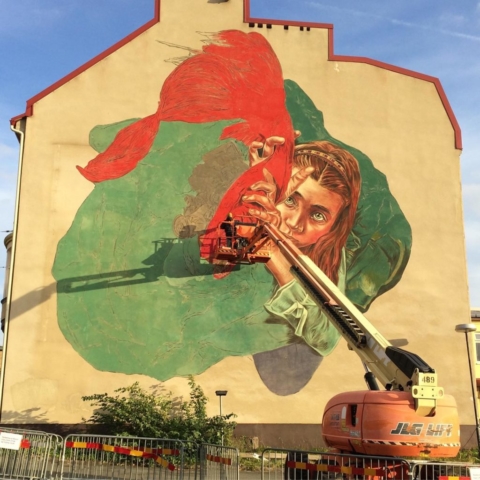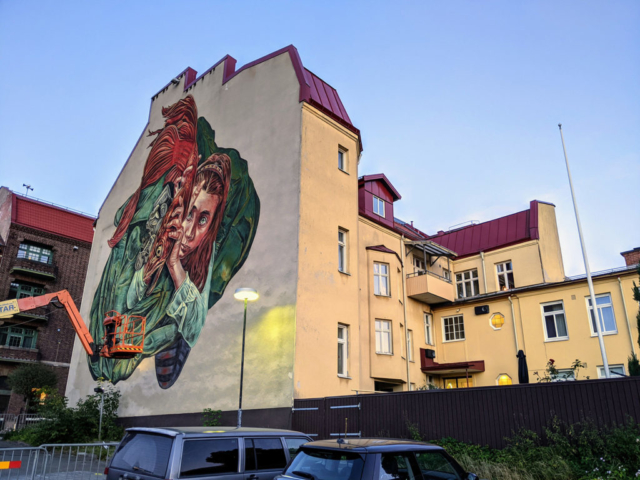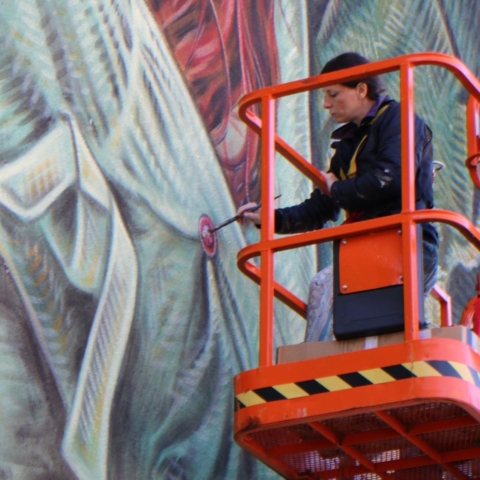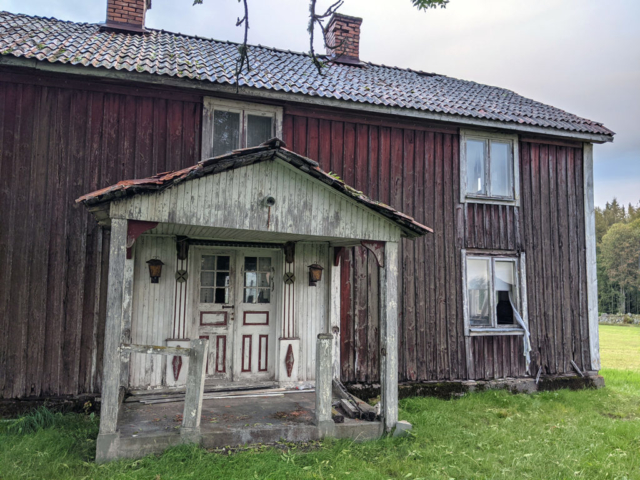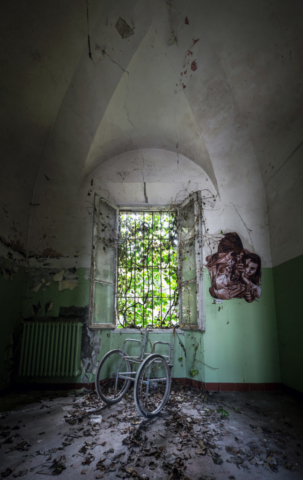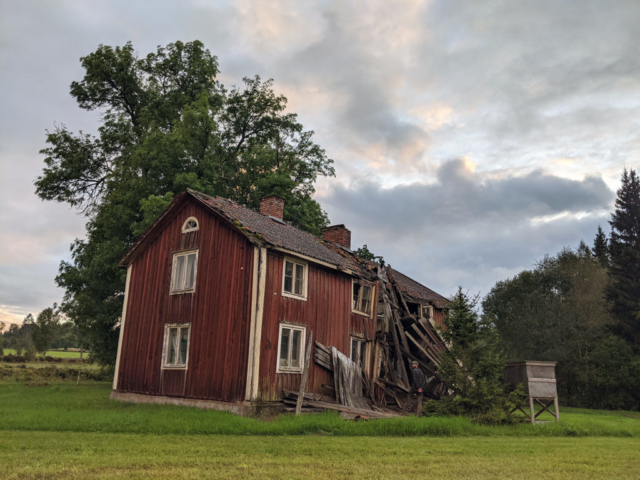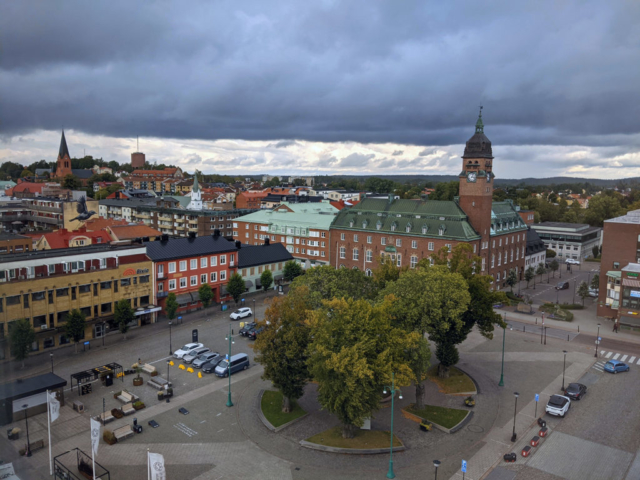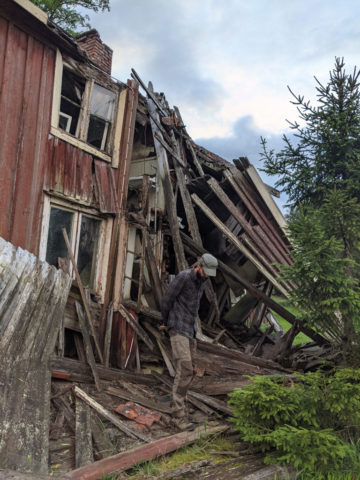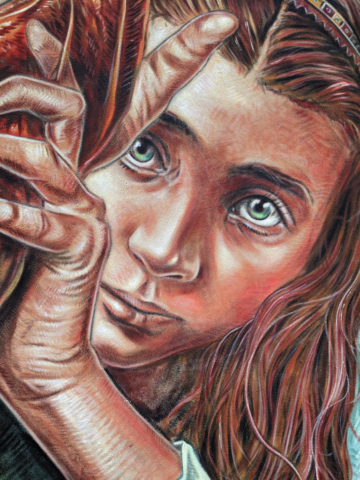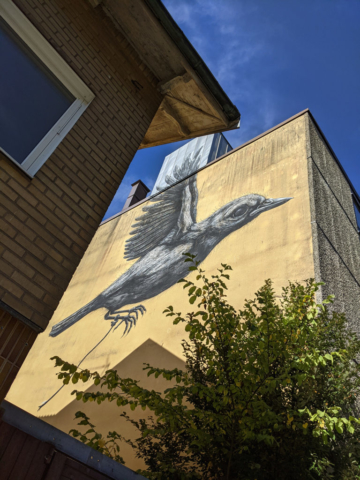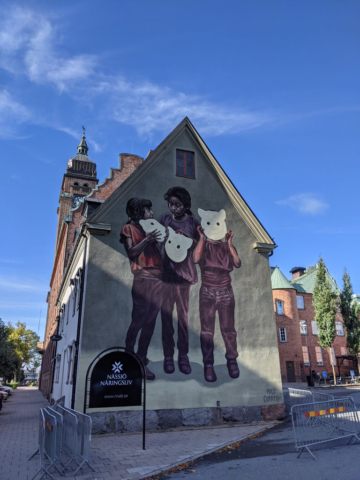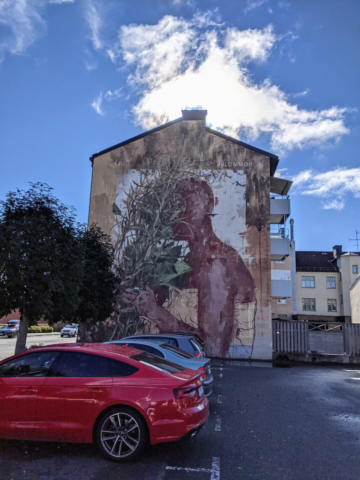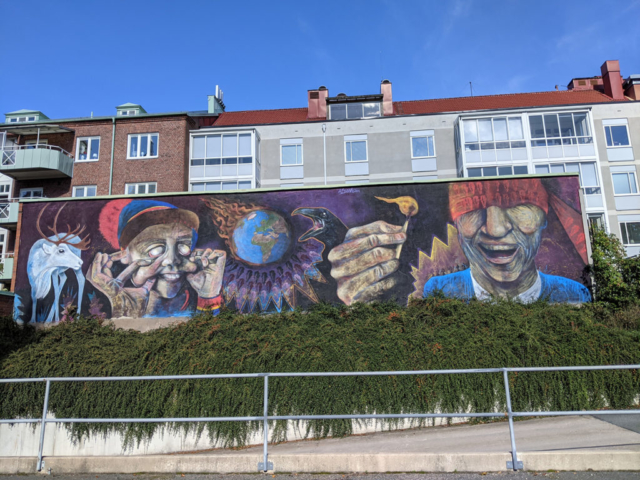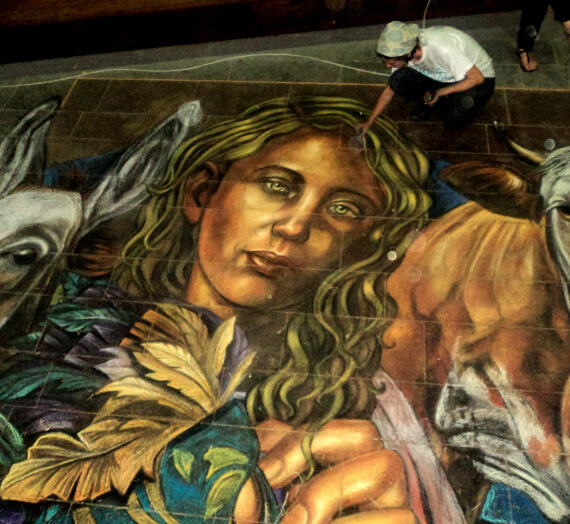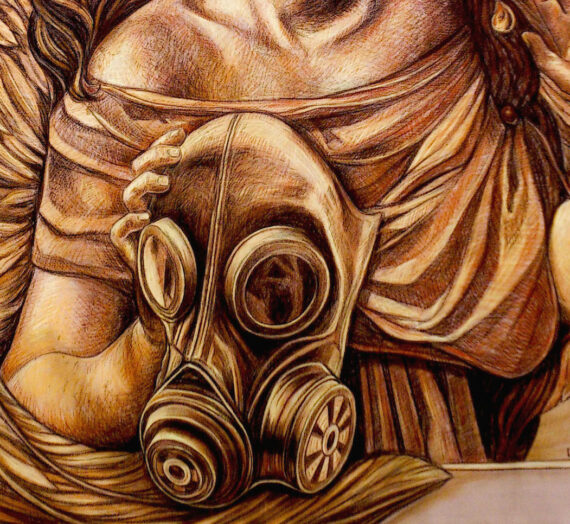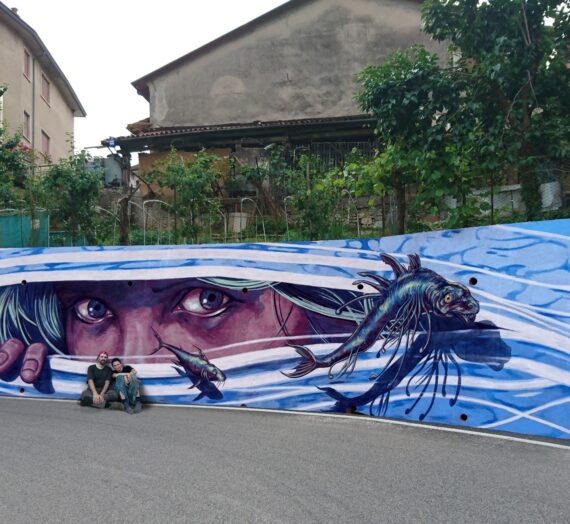“Le celle sono il luogo più doloroso” è il mio ultimo progetto svedese.
Un’enorme ragazzina fluttuante nell’atto di afferrare (rilasciare?) un grottesco animale fantastico, un pesce terrorizzato che reca nel corpo monocroma spazzatura.
L’opera è dedicata alla malattia mentale e il bozzetto risale al 2019. È una storia curiosa.
Stavo attraversando un periodo difficile e avevo creato tre pezzi autobiografici con lo scopo di installarli in un sito abbandonato. Uno dei tre era proprio la bambina volante.
La location individuata era un vecchio manicomio italiano oltremodo suggestivo, un sito da togliere il fiato, proprio il luogo che desideravo ospitasse le mie opere.
Ovviamente dopo esservi entrata mi ero già pentita della scelta, avevo i brividi. Più che un’azione catartica per la mia salute si stava rivelando una nemesi dell’ego.
Mea culpa, ormai però ero là, e dovevo strisciare fino ad incontrare i muri giusti.
Ad un certo punto una saletta verde con una finestra ad inferriate invasa da un’edera morente. A terra restava un tappeto di foglie secche sulle quali campeggiava una sedia a rotelle malmessa. Natura che si prendeva spazi fino ad essere coinvolta dalla stessa caducità che aveva consumato l’edificio e chi vi aveva vissuto.
Avevo trovato la stanza per la bambina.
In meno di due mesi il pezzo è sparito. Una conoscente mi ha inviato una fotografica del muro con la sagoma della colla a mo’ di sindone. Vagheggiavo una furia iconoclasta, invece forse a qualcuno è piaciuto, ohibò. Che si pigliasse pure gli acciacchi, il malandrino.
Il giorno seguente mi è arrivata una mail dalla Svezia con la proposta di Kalinka Ussing, curatrice della Nässjö Konsthall: portare l’opera su una grande parete della città.
Ero indecisa, quello era un pezzo intimo. Poteva essere un modo per esorcizzare le mie paure? Avrebbe potuto rendere il mio disagio volatile come un disegno magicamente scomparso?
Come immaginerete facilmente, ho accettato. Il progetto era previsto per maggio 2020. Poi la pandemia ha bloccato tutto ma alla fine sono partita, un anno e mezzo dopo, col cuore in mano e le mani tremanti.
Il titolo è ispirato ad un libro di Mario Tobino, Le libere donne di Magliano, un’opera autobiografica che racconta della sua attività di medico nel reparto femminile dell’ospedale psichiatrico di Maggiano, un’esperienza totalizzante iniziata nel 1942 e durata quarant’anni.
Mi aveva colpito il suo modo di interagire con le pazienti, con profonda empatia. Non riuscivo a dimenticare la descrizione delle celle per le ‘agitate’, il luogo più doloroso, e il racconto delle alghe marine.
Ne riporto alcuni passaggi:
“Le celle sono il luogo più doloroso (…) fra quelle nude pareti, fuoriescono i loro gesti, prorompono parole intermezzate da canti, la palla lanciata delle imprecazioni.
Esiste un’erba, presso le coste di certi mari, che si radica agli scogli e molleggia verso la superficie; quest’alga marina dalle lunghissime ciglia, contiene iodio e, staccata, seccata, emana calore; se un uomo nudo vi si ravvolge si riscalda; e per di più l’alga ha la buona qualità che non s’incendia, non prende fuoco, e la si può lavare. L’alga è usata nelle celle; un mucchietto, accatastato presso la parete, è in attesa di un matto che tra le sue file comporrà la tumultuosa follia, canterà ciò che l’opprime, svelerà in quella solitudine il suo mistero; il mucchietto d’alga sarà la sua coperta e il suo vestito, quelle lunghe file di erba marina l’oggetto del suo furore, le potrà strappare e attorcigliare, e, quando sarà stanco, potranno avvolgerlo e riscaldarlo, un tepore lo potrà conciliare col sonno.
E se invece continua la massina agitazione può urlare ventiquattro su ventiquattro ore senza che alcuno lo rimproveri, nominare selvaggiamente il nome di Dio, pisciare verso l’aria e contro il muro, defecare ridendo, con lo sterco disegnare le bianche pareti, scrivere su i muri nomi accompagnati dagli insulti più profondi, bere la sua stessa orina, ballare cantando e arruffandosi la chioma come un Bacco eccitato, pacatamente in sé stesso confabulare, dare alla voce il tono conciliativo.
L’alienato nella cella è libero, sbandiera, non tralasciandone alcun grano, la sua pazzia, la cella suo regno dove dichiara sé stesso, che è il compito della persona umana.”
Oggi il manicomio di Maggiano – abbandonato gradualmente a partire dal 1978, in seguito alla legge Basaglia, e chiuso in via definitiva nel 1999 – è stato trasformato in un museo. Vi si trovano raccontati non solo i malati di mente ma anche donne con figli illegittimi, poveri che non avevano un altro posto dove andare e in generale tutti i diseredati della società, bollati come “matti” secondo le convenzioni sociali del tempo.
Tutto questo voleva contenere la mia opera, tentando di edulcorare un poco tanta sofferenza con l’immedesimazione onirica e surreale, tipica della mia poetica.
Il 3 settembre quindi sono partita, il primo volo dopo quasi due anni. Il 400esimo volo forse, in dieci anni, panico come fosse il primo, mani sudate, senso di inadeguatezza. Ho chiesto aiuto ad Andrea, proponendogli un connubio di viaggio e boschi nordici.
Dopo 13 ore siamo arrivati a Nassjo e Ninni Forssmed, nuova curatrice del progetto insieme a Par Jonsson, ci ha mostrato la città, le opere di Roa, Borondo, Milu Correc, la splendida Biblioteca e la Galleria d’Arte.
Infine siamo arrivati alla mia parete. Ho toccato il muro rabbrividendo, un mega strollato, una superficie impossibile per chi come me lavora a pennello. Temevo di non poter dipingere e invece, grazie a enormi rulli e all’entusiasmo di Andrea, siamo riusciti a dare delle basi piatte che, considerata la misura e la distanza, funzionavano.
Così mi sono lasciata andare alla pittura, io sul cestello, Andrea nei boschi alla ricerca di alci, entrambi nel proprio humus naturale.
Otto giorni fitti fitti, parlavo da sola, monitorata dalle due taccole in cima al muro. Nel frattempo Andrea aveva trovato alcuni alci e luoghi incantati ma anche tante zecche e mosche dei cervi. Mi raccontava di quei boschi e delle torbiere la sera, quando riusciva a staccarmi dalla piattaforma.
Ho firmato mentre la pioggia scrosciava ma ormai l’opera era terminata, avevo avuto una settimana di sole, fredda solo i primi giorni, una fortuna. Ma ero stravolta. Sono quasi soffocata con un sorso d’acqua tanto ero concentrata su quelle celle dolorose.
Forse sono ancora qui, le celle. È difficile liberare la mente e trovare un regno dove dichiarare sé stessi ma soprattutto ridimensionare quel regno per evadere verso la luce.
L’opera parla proprio di questo, della difficoltà di relazionarsi con quella coscienza che si divincola come uno strano pesce. La ragazzina lo stringe con una mano, lo lascia andare (o lo accoglie, lo protegge?) con l’altra. Una metafora dell’esistenza, in continua lotta manichea.
Non sa cosa sia l’adeguatezza, questo pesce col capo da barracuda e il corpo da pesce rosso, questa teratologia che tutti vestiamo lungo la vita. La spazzatura resta di lato ma si accumula, è quel che non siamo in grado di cogliere, ciò che non accettiamo di noi stessi. In contonuo diverbio con aspetti e sensazioni che abbiamo ereditato, costruito e foraggiato.
(Now in English!)
“Cells are the most painful place” is my latest Swedish project.
A huge little girl floating in the act of grabbing (releasing?) a grotesque fantastic animal, a terrified fish that carries monochrome garbage in its body.
The work is dedicated to mental illness and the sketch dates back to 2019. It’s a curious story.
I was going through a difficult time and had created three autobiographical pieces with the aim of installing them on an abandoned site. One of the three was the flying child girl.
The location identified was an old Italian asylum extremely suggestive, a site so interesting to take your breath away, exactly the place I wanted to host my works.
Obviously after entering it I had already regretted the choice, I had chills. More than a cathartic action for my health, it was turning out to be a nemesis of the ‘ego’.
It was my fault but I was already there, and I had to crawl until I met the right walls.
At one point a green room with a window with railings invaded by a dying ivy. On the ground remained a carpet of dry leaves on which stood a battered wheelchair.
Nature that took up space until it was involved in the same transience that had consumed the building and those who had lived there.
It was the perfect room for the little girl.
In less than two months the piece is gone. A friend sent me a photograph of the wall with the shape of the glue like a shroud. I was longing for an iconoclastic fury, but maybe someone liked it.
The following day I received an email from Sweden with the proposal of Kalinka Ussing, curator of the Nässjö Konsthall: to bring the work on a large wall of the city.
I was undecided, that was an intimate piece. Could it be a way to exorcise my fears? Could it have made my discomfort volatile like a magically disappeared drawing?
As you will easily imagine, I agreed. The project was scheduled for May 2020. Then the pandemic blocked everything but at final I left, a year and a half later, with my heart in my hand and my hands trembling.
The title is inspired by a book by Mario Tobino, Le libere donne di Magliano, an autobiographical work that tells of his activity as a doctor in the women’s ward of the psychiatric hospital of Maggiano, an all-encompassing experience that began in 1942 and lasted forty years.
I was struck by his way of interacting with patients, with deep empathy. I could not forget the description of the cells for the ‘agitated’, the most painful place, and the story of seaweed.
Here are some of the steps from the book:
“Cells are the most painful place (…) between those bare walls, their gestures come out, words interspersed with songs burst out, the ball thrown by curses.
There is a grass, near the coasts of certain seas, which takes root in the rocks and springs towards the surface; this sea alga with very long eyelashes, contains iodine and, detached, dried, gives off heat; if a naked man turns up in it, he warms up; and what’s more, the alga has the good quality that does not catch fire, does not catch fire, and you can wash it.
Algae is used in cells; a pile, stacked near the wall, is waiting for a mad man who among his ranks will compose the tumultuous madness, will sing what oppresses him, will reveal his mystery in that solitude; the pile of seawed will be his blanket and his dress, those long rows of sea grass the object of his fury, he can tear and twist them, and, when he is tired, they can wrap and warm him, a warmth can reconcile it with sleep.
And if instead the massive agitation continues, he can scream twenty-four hours without anyone reproaching him, wildly name the name of God, piss towards the air and against the wall,
defecate laughing, with the dung draw the white walls, write on the walls names accompanied by the deepest insults, drink his own urina, dance singing and ruffling the hair like an excited Bacchus, quietly in himself confabular, give the voice the conciliatory tone.
The alienated in the cell is free, flaunts, not neglecting any grain, his madness, his kingdom cell where he declares himself, which is the task of the human person.”
Today the asylum of Maggiano – gradually abandoned since 1978, following the Basaglia law, and definitively closed in 1999 – has been transformed into a museum. There are told not only the mentally ill but also women with illegitimate children, poor people who had no other place to go and in general all the dispoest-demented of society, branded as “crazy” according to the social conventions of the time.
All this meanings I wanted to put my work, trying to sweeten a little so much suffering with the dreamlike and surreal identification, typical of my poetics.
So on September 3rd I left, the first flight in almost two years. The 400th flight perhaps, in ten years, panic as if it were the first, sweaty hands, sense of inadequacy. I asked Andrea for help, proposing a combination of travel and Nordic woods.
After 13 hours we arrived in Nassjo and Ninni Forssmed, the new curator of the project together with Par Jonsson, showed us the city, the works of Roa, Borondo, Milu Correc, the splendid Library and the Art Gallery.
Finally we arrived at my wall. I touched the wall shivering, a hug strolled/rough wall, an impossible surface for those like me who work with a brush.
I was afraid of not being able to paint therefore, thanks to huge rollers and Andrea’s enthusiasm, we were able to give flat bases that, considering the size and distance, worked.
So I let myself go to painting, working on the basket while Andrea were in the woods looking for animals, both in their own natural humus.
Eight busy days, I spoke alone, monitored by the two jackdaws at the top of the wall. In the meantime Andrea had found some elk and enchanted places but also many ticks and deer flies. He told me about those woods and peat bogs in the evening, when he managed to detach me from the platform.
I signed while the rain was pouring but by now the work was finished, I had had a week of sunshine, cold only the first few days, lucky weather there. But I was really tired. I almost suffocated with a sip of water so I was focused on those painful cells.
Maybe cells they are still here. It is difficult to free the mind and find a kingdom where to declare oneself but above all to resize that realm to escape into the light.
The work speaks precisely of this, of the difficulty of relating to that consciousness that wriggles like a strange fish. The girl squeezes him with one hand, lets him go (or welcomes him, protects him?) with the other. A metaphor of existence, in continuous Manichean struggle.
This strange fish, with the head of a barracuda and the body of a goldfish, does not know what adequacy is. This fish is the teratology that we all wear throughout our lives. The garbage remains on the side but accumulates, it is what we are not able to grasp, what we do not accept about ourselves. Fighting against aspects and sensations that we have inherited, built and fostered.
Thank you Nassjo Konsthall, Nassjo Kommun and the Major, Ninni Forssmed, Par Jonsson, Kalinka Ussing and all the people who passed by and appreciated my work in the city 🙂
